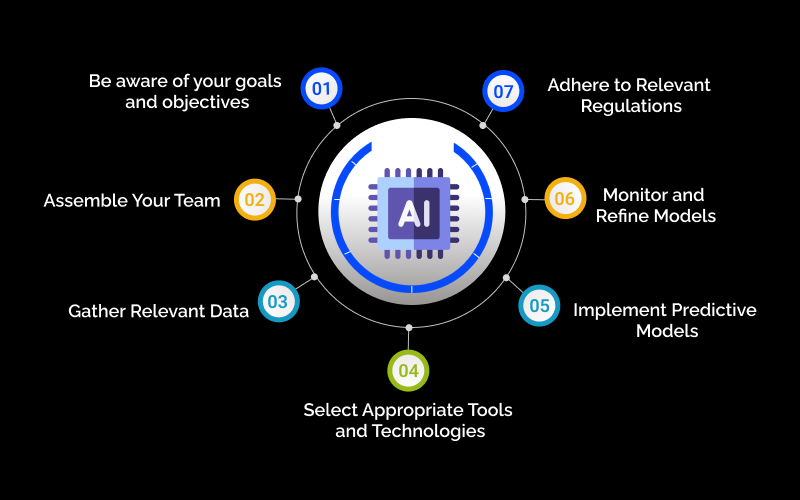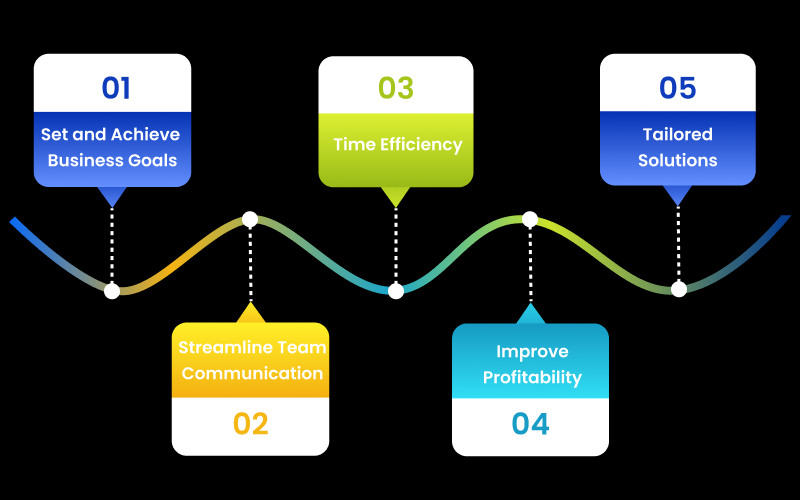AI
Top 7 Useful AI Data Analysis Tips for Enhanced Decision-Making
 Updated 31 May 2024
Updated 31 May 2024

Cultivating a modern business requires making critical decisions to accelerate and sustain growth. Picking the right course of action and time to put the wheels into motion are invaluable to business strategy.
But how are you to go about doing this? Yes, the answer has always been data.
While data analysis can turn oodles of raw data into useful insights that support the decision-making process, using AI in data analytics can make this extensive and time-consuming process a viable solution for the fast-paced modern business environment.
This article shall discuss the top 7 AI data analysis tips to help your business quickly and effectively leverage artificial intelligence’s latest capabilities, and explain the importance of using AI to stay competitive.
Rise of AI in Data Analysis
According to Gartner, only 29% of strategists can say that their organisations can respond as quickly as needed to tackle disruptions. Today, top companies worldwide are investing heavily in AI Development Services to support strategic and analytical processes to address this issue and pivot as needed with speed and efficiency.
An article published by PWC shows that AI implementation has proliferated into Travel and hospitality by 89%, technology, media, and telecom by 86%, financial services by 82%, and healthcare and pharma by 73%. The same article also contained a gem of knowledge we agree with – “businesses need to start viewing it(AI) as a necessity rather than a luxury.”
Adobe proudly published how its AI-powered customer journey analytics solution delivered a 431% return on investment and increased productivity by 30%.
The 2024 report from Juliety presented that 53% of US B2B marketers employ AI for data analysis to enable the quick generation and processing of leads.
A CNBC survey from 2023 shows that 47% of the companies in its purview named AI as a top priority. Indeed, with new and intriguing ways being discovered every day in which AI can improve business functions and profitability, not incorporating the technology in at least some form now would be tantamount to denying yourself a competitive edge.
7 Tips to Apply AI and ML in Data Analysis

1. Be Aware of Your Goals and Objectives
Defining goals and objectives is always the first step in any process. This is the same for successfully implementing AI and ML in your data analysis and decision-making exercises. To leverage these technologies to enhance business processes, customer retention, sales, or other purposes, you must first clearly understand the problems you need to solve and how AI and ML will contribute to the solutions.
You can target precise, measurable outcomes through predictive analytics by being specific about your business goals and objectives.
2. Assemble Your Team
One of the most important prerequisites for successful AI and ML implementation for data analysis is to ensure that you have a team that possesses the skills needed to operate and understand how the flow of data works and the analysis methodologies work.
To ensure that reports and dashboards consider the correct data and use the correct analytical models, your team should include data scientists, business analysts, data engineers, and IT specialists. Partnering with external experts like Q3 Technologies is also a good option if you wish to empower your team with vetted resources.
3. Gather Relevant Data
As mentioned, any analysis requires collecting relevant data, such as historical data, external datasets, and real-time data streams. The need to cleanse the data to remove errors or inconsistencies and process it for modeling cannot be overstated.
A single error can result in outputs that suggest completely different decisions than what may be needed. As such, the foundation on which the whole process is based (the data) must be accurate and relevant.
4. Select Appropriate Tools and Technologies
To benefit from AI and ML in data analysis and decision-making, choose tools and technologies that meet your specific needs. This might include programming languages like Python and R for custom model development, or platforms like Tableau for data visualization.
Decide whether to use cloud-based analytics services or on-premises solutions based on your data security, budget, and scalability requirements.
5. Implement Predictive Models
Successfully using AI and ML for business data analysis to base decisions requires selecting the right predictive modeling techniques. This decision is based on factors like the specific problem you are addressing and data characteristics.
Train different prospective models with a subset of your data and validate their performance with another subgroup. It is best to ensure that your chosen model is accurate and generalizes well to new data since you will base critical decisions on it.
6. Monitor and Refine Models
Predictive models in business are not static solutions. Continuously update and improve them based on new data and changing conditions. Regularly retrain your model with fresh data to keep it relevant and accurate.
Optimize your model by testing different configurations, feature selections, and parameter adjustments. Establish a feedback mechanism to monitor the model’s real-life performance, identify areas for improvement, and update the model accordingly.
7. Adhere to Relevant Regulations
Ensure ethical compliance when using AI predictive models for business data analysis and decision-making, particularly regarding transparency, privacy, and bias. Ethical AI practices also contribute to risk management and trustworthiness.
Adhere to industry standards and regulations to establish legal and ethical responsibilities, protecting your organization from legal issues and enhancing its market reputation.
Read Our Case Study: Elevating Recovery Rate (RR) And Reducing Loan Default Using AI-Driven Predictive Analytics For A Leading Financial Lender
Impactful Areas Where AI Can Assist in Decision-Making
Data Hygiene and Warehousing
AI can automate the extract, transform, and load (ETL) process. By automating tasks, and optimizing performance, the potential for human error is reduced and the time and effort that are typically needed is cut down greatly.
It also makes for faster and more effective data retrieval and an assurance that strict data governance principles are followed, ensuring compliance with laws and industry norms.
Creating Dashboards & Reports
AI tools can instantaneously create immersive and manipulatable dashboards and reports that can help you extrapolate insights and findings from large volumes of data. Intelligent visualizations created by AI can also help users find hidden patterns and trends in the data that might have been overlooked otherwise.
Automating Data Collection
The AI-powered intelligent automation that handles repetitive tasks feeds directly into data repositories that can be used for creating reports. This process ensures that the data being used to create the reports is free of errors like duplication and false entries and that no data is missing.
Complete and error-free data is necessary to produce insights that are not skewed, leading to you making wrong assumptions and critical decisions.
Inventory Management Decisions
Predicting product demand with highly accurate forecasting and tracking inventory using technologies like IoT can help you optimize inventory management and avoid stockouts and overstocking.
Stockouts result in your business losing potential sales and reducing excess inventory lowers carrying costs. A well-managed inventory system can be crucial in ensuring profitability.
Benefits of Implementing AI in Data Analytics with Q3 Technologies
Q3 Technologies has proven its metal in over twenty-five years of providing high-quality customized technological solutions to numerous companies of different sizes across every industry. Their Machine Learning Development Services provider performance has also achieved nothing short of excellence.
Below are listed the benefits that working with Q3 Technologies to apply ML and AI in data analytics can bring to your business –

1. Set and Achieve Business Goals
Q3 enables your business to use AI to discover and set realistic and attainable goals by providing precise and actionable insights. Analyzing past performance and current trends, our AI tools can help you plan strategically and ensure that the goals set are based on solid data, allowing for better resource allocation.
2. Time Efficiency
The customized AI solutions offered by Q3 significantly reduce the time required to analyze large volumes of data. Using AI in data analytics delivers results faster and more accurately than traditional data analysis methods which can be time-consuming and prone to human error. This efficiency allows businesses to respond to market changes in real-time.
3. Tailored Solutions
Personalization is key to customer satisfaction, and the intuitive AI solutions designed by Q3 Technologies excel in this area. By analyzing user data to understand preferences and behaviors, you can create tailored solutions for each client, improving engagement and loyalty and fostering long-term customer relationships.
4. Streamline Team Communication
Q3 helps you develop AI tools specific to your business needs by analyzing interaction patterns and suggesting improvements. AI can help identify the most effective communication channels, recommend optimal meeting times, and automate routine tasks leading to better collaboration, reduced misunderstandings, and a more cohesive work environment.
5. Improve Profitability
The ultimate goal of the business is to make a profit after all. By providing detailed insights into various aspects of business operations, Q3 Technologies lets you use AI and ML in data analytics to identify cost-saving opportunities and revenue growth areas to make the best decisions based on solid facts to grow and sustain your business.
Conclusion
To conclude, incorporating AI and ML in your data analysis and decision-making processes has emerged as a revolutionary force in the business world, driving efficiency, accuracy, and innovation. Powering decisions using AI is now a necessity of the modern business rather than a want, that lets it drive strategic growth, and stay competitive.
These practical AI data analysis tips will guide you in harnessing the full potential of the technology and unlock avenues for growth that you may otherwise have never discovered.
Step into this future with Q3 Technologies and watch your business thrive like never before. The future of your business is data-driven, and with AI and ML, the possibilities are limitless.
Read More: Top Generative AI Use Cases Across Industries in 2024
FAQs
Q. How does AI help with data analysis?
A. AI enhances data analysis by automating the processing of vast datasets, identifying patterns, and generating insights. Machine learning algorithms can predict trends and outcomes based on historical data, while natural language processing enables the extraction of information from unstructured sources. AI tools streamline data cleaning, integration, and visualization, providing more accurate and timely insights.
Q. How can AI improve decision-making?
A. AI provides data-driven insights, predictive analytics, and real-time analysis to support decision-making. It reduces human error and biases, enabling more accurate and objective decisions. AI systems can analyze complex datasets quickly, offering recommendations and identifying opportunities or risks. AI also helps make proactive, informed choices by forecasting future trends and simulating potential outcomes.
Q. How AI has changed the decision-making process in real-time analytics?
A. AI has revolutionized real-time analytics by enabling immediate data processing and insight generation. It facilitates the continuous monitoring of data streams, detecting patterns, and anomalies as they occur for a swift response to changing conditions. This along with the optimization of operations and AI-powered real-time analytics, enhances the agility and responsiveness of the business.
Q. How does artificial intelligence impact business strategy and decision-making processes?
A. AI-driven insights help refine business strategies, improve customer experiences, and drive innovation, leading to competitive advantages and better overall performance. AI enables businesses to analyze large datasets and uncover trends and correlations that inform strategic decision-making. It also identifies potential threats and opportunities to help stay proactive.
Q. What are some popular tools and technologies for AI and ML?
A. Popular tools include programming languages like Python and R for model development and platforms like Tableau for data visualization. Additionally, consider whether to use cloud-based or on-premises solutions based on your needs.
Q. How do I choose the right predictive modeling techniques?
A. Choose techniques based on the characteristics of your problem and data. You can experiment with different models and validate their performance using subsets of your data.
Q. How often should I retrain my predictive models?
A. Retrain your models regularly, depending on the volume and velocity of new data, to maintain their accuracy and relevance.
Q. How do I measure the success of AI and ML implementations in my business?
A. Measure success by evaluating the achievement of specific, measurable business goals, improvements in decision-making accuracy, efficiency gains, and overall business performance enhancements.
Explore More

Artificial Intelligence
40 Innovative Artificial Intelligence Project Ideas For Beginners

Artificial Intelligence

